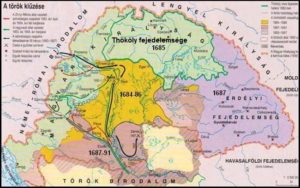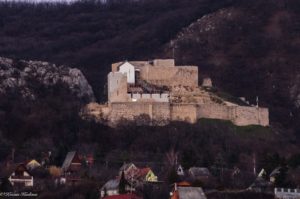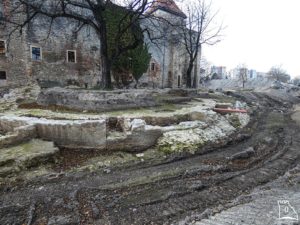Palota (Várpalota)

Palota is famous for its castle, also called “Thury Castle”. It used to be an important Borderland castle of the Trans-Danubian region of Hungary during the Ottoman wars between Lake Balaton and Lake Velence. The name Várpalota (“Vár” means “castle” and “palota” means “palace” in Hungarian) came into use shortly after 1870. The large castle had four towers at its corners and was situated in the middle of a marshy area. It is one of the few Hungarian castles to have survived all the wars in the most intact condition. Palota Castle, with the Bakony Hills in the background, used to guard the road between Székesfehérvár and Veszprém. During the Ottoman wars, it had to withstand six heavy sieges.

The castle is also called Thury Castle after Thury György, its famous captain who managed to repel the overwhelming Ottoman forces in the summer of 1566. (Note that I use the Eastern order of Hungarian names, where the surname comes first). Palota was taken by the Turks only in 1593 and was liberated only 94 years later.

The Szalók clan settled here after the Magyar tribes had conquered the land in the 9th century. Originally, the Palota castle was situated in another place, 5 kilometres away. It was identical to the Bátorkő (Brave Stone) castle built by the Csák clan. Nowadays Bátorkő Castle is also called Pusztapalota, which can be quite confusing. All documents written before 1440 refer to Pusztapalota Castle.

Here you can read more about Bátorkő castle:
https://www.hungarianottomanwars.com/kingdom-of-hungary/batorko/

King Károly Róbert acquired Bátorkő Castle from the Csák family in 1326. It was one of the castles the king exchanged with them because the Csák family owned too much land in the region. Then, in 1350, King Louis the Great gave the castle to the ancestors of the Újlaki family. As the new owners found the Bátorkő castle too small, they began to build a more comfortable and larger palace in Bátorkő around the turn of the century. It became a real “palace”, also called “palota” in the Hungarian language, and so the Palota Castle was mentioned in a document in 1397.

It was Újlaki Miklós, one of Hungary’s richest oligarchs, who had the castle built on its present site between 1439 and 1445. It was a real fortress with an inner tower. Later, King Matthias Corvinus and his queen Beatrix visited the place. In fact, they were preparing for their wedding in Palota Castle in 1476. After the death of King Matthias, the Habsburg troops occupied the Trans-Danubian castles. They also took the castle of Fehérvár. King Ulászló II stayed in Palota to recover from his illness. He organized the defense of the kingdom from the comfortable but strong castle of Palota.
Lord Újlaki Lőrinc made a contract with the other richest lord of the country, Szapolyai István in 1493. According to the contract, Szapolyai should have inherited Palota Castle. When Újlaki died in 1524 without a male heir, his widow, Lady Bokovczai Magdolna, remarried. Her new husband was none other than the notorious robber knight Móré László of Csula. The Diet of Hatvan decided to take away Palota Castle from him, but Móré refused to give it back.

Finally, in 1533, King Szapolyai János had to send an army there, led by his Polish diplomat Jeromos Laszki. When Nagy Gergely, Palota’s castellan, heard of his coming, he immediately fled. Lord Móré left the besieged castle in secret a short time later. He didn’t wait for the 50 Bohemian miners from Laszki to finish their work and blow up the walls.

Thus, Laszki received the castle of Palota from King Szapolyai. However, Laszki betrayed his king and left him in 1537. Then Szapolyai gave the castle to Podmaniczky János and Rafael, noblemen from the lands of Upper Hungary. The Podmaniczky brothers soon reinforced the castle and modernized it according to the artillery development of the time. They also added a round bastion to guard the gate.
The Turks occupied it in 1543 under the leadership of Bey Ulema, but we can find Hungarian guards in it again in 1548. In 1549 it was Bey Veliszán of Fehérvár Castle who besieged it, but in vain. Palota was indeed a strategic castle in the Hungarian frontier and it was able to repel the Turkish attacks for 50 years, but it was always neglected by the king. It was undermanned, underpaid, in bad condition, and difficult to defend on its terrain.

The troops of Bey Arslan tried to take it in 1551, but they were beaten back. Between 1552 and 1566 the defenders of Palota were under tremendous pressure due to the capture of Veszprém Castle by the Turks. When Podmaniczky Rafael died in 1559, his widow had to cede Palota to the Habsburg king, who appointed Thury György as his captain. Thury was not only a great duelist, the hero of 600 duels, the “Hungarian El Cid”, but he was also a good strategist.
He had the bastions of Palota repaired, and the moats cleaned, and did his best to stockpile food and ammunition. Since he didn’t get any money from the king, he wrote him many letters, we know such as letters from 1559 and 1565. Meanwhile, the enemy tried a trick to take the castle, but Thury outwitted them. Here is more about this case:

Thury had barely 200 hussars and 200 riflemen guarding Palota Castle when Pasha Arslan of Buda desperately attacked the fortress in June 1566 with an overwhelming force of 8,000 soldiers and many cannons. When the enemy surrounded the castle and night fell, all the hussars broke out noiselessly and attacked the sleeping Ottoman warriors. They made such a wild noise, setting fire to everything that could be burned, that Pasha Arslan began to panic. He was even more panicked when reports came in that a huge army of reinforcements was approaching the castle.

He didn’t know that it was only the noise of the magistrate of Győr who had sent many carts to Bakony Hill to collect wood and branches. Many of the citizens of Győr were Germans, and they spoke and sang in German as they worked. Pasha Arslan began to whine and moan and gave the order to retreat. In return, the Sultan gave him a silk string. It should be mentioned here that the German General Salm was hunting near Győr, not caring about Palota’s danger. He arrived with his troops three days later.

When Salm finally arrived with reinforcements, Thury joined him with his hussars and together they retook the castles of Tata and Veszprém. Thury then resigned from his post, as it was impossible to finance the defense of Palota without the King’s help. His cousin, Thury Márton, was appointed by the king to lead Palota. Márton was not idle either: in 1568 he repulsed the attack of Pasha Mustafa. This was the period when the famous military engineer Giulio Turco (1572) worked in the castle. As for Thury György, he was slaughtered by the Turks a few years later, in 1571, when he fell into a trap at Orosztony in Zala County.

The new captain of Palota in 1573 was Pálffy Tamás, who managed to strengthen the fortress – he led a series of victorious raids against the Turks until 1581. Despite this, there were times when no more than 30 soldiers guarded the castle, but they were able to hold it. Lord Pálffy was also a famous duelist of the Valiant Order: in 1577 he killed the famous Ottoman warrior Bey Kara Ali of Fehérvár by piercing him with his lance. We know of another duel he fought in 1580 when he also challenged the new Bey of Fehérvár. (It was a tricky habit among the members of the Valiant Order: when a “fresher” was appointed by the Sultan, he was immediately challenged and, if possible, killed in a duel).

The next inscription can be read on Pálffy’s tombstone: “The castle of Palota bears witness to how often he defeated the enemy. From his youth, he served his country. He liberated many Hungarians from Ottoman slavery, he served the betterment of many people. The glory of his deeds will live forever”. You can read more about him in my article here:
https://www.hungarianottomanwars.com/essays/palffy-tamas-1534-1581-a-hungarian-hero/

The Ottomans finally captured the castle during the 15 Years’ War in 1593, when the captain, Ormándy Péter, made a heroic effort to defend the fortress with a handful of men. Eventually, he had no choice but to enter into negotiations and cede Palota to the Turks. Pasha Sinan, the Grand Vizier, promised him that he and his people would be allowed to leave the castle safely, but the Ottomans broke their word and slaughtered his men. Ormándy barely managed to escape. Then the military council in Győr sent him to prison for surrendering Palota.

Five years later, when the Christian troops recaptured Győr from the enemy, they launched a general attack on the Turkish border castles of the Trans-Danubian region, led by Pálffy Miklós and Adolf Schwarzenberg. They recaptured the castles of Csókakő, and then Gesztes, then they laid siege to Palota. Two days later the Ottomans surrendered and the castle returned to Hungarian hands.

The Turks recaptured it in 1605 when Köse Hussein’s troops captured Veszprém Castle. We know that the Ottoman commander Schemann had 91 cavalrymen, 102 infantrymen, and 13 artillerymen within the walls. However, the Ottomans emptied the fortress in 1614 for unknown reasons, so it was repeatedly returned to the Christians. The new owner was Zichy Pál. However, he was not very popular with his men. When the army of the Transylvanian prince Bethlen Gábor approached, Zichy’s own soldiers drove him out and ceded the castle to the prince in 1620.

When the peace treaty between the Habsburgs and Bethlen was signed at Nikolsburg in 1621, Palota returned to King Ferdinand II. The king gave it to Czirák Mózes and in 1624 we can meet Zichy Pál again as his castellan. However, there were so many complaints against him that he was dismissed and became the new captain of Győr Castle instead. Four years later the Ottomans conquered Palota. They were driven out in 1660 but retook it in 1669.


Zichy István recaptured Csókakő on 17 October and sent his artillery expert, Brother Gábor (nicknamed ‘Fiery’ Gábor). He was a very talented artilleryman who excelled not only in the siege of Buda Castle but also in the capture of Csókakő. The monk arrived in Palota on 20 October and immediately used his incendiary bombs. Within two days he forced the defenders to surrender. The enemy left the castle on the condition of safe conduct. When the Ottomans finally surrendered Palota, 68 armed men, 97 women, and 39 children left the castle. They were escorted to Buda and from there to Ottoman territory.

By 1702, Palota Castle was in a very dilapidated state and Emperor Leopold I wanted to blow it up like so many other former Borderland castles. Fortunately, the county estates successfully appealed against this decision. The rebel ‘kuruc’ troops of Prince Rákóczi Ferenc, led by General Bottyán the Blind, managed to take Palota in 1705. The commander of Palota in 1707 was Domonkos Ferenc, who was able to repel the army of Baron Pleffershofen. After the end of the War of Independence, Imperial General Rabutin blew up the two northern corner towers of the castle. Palota became the property of the Zichy family, who carried out many reconstructions in the castle until 1889.

Dear Readers, I can only make this content available through small donations or by selling my books or T-shirts:
Please, feel free to support me with a coffee here:
You can check out my books on Amazon or Draft2Digital, they are available in hardcover, paperback, or ebook:
https://www.amazon.com/dp/198020490X or at https://books2read.com/b/boYd81

My work can also be followed and supported on Patreon: Become a Patron!http://Become a Patron!

[wpedon id=”9140″]

https://hungarianottomanwars.myspreadshop.com/all



















































































